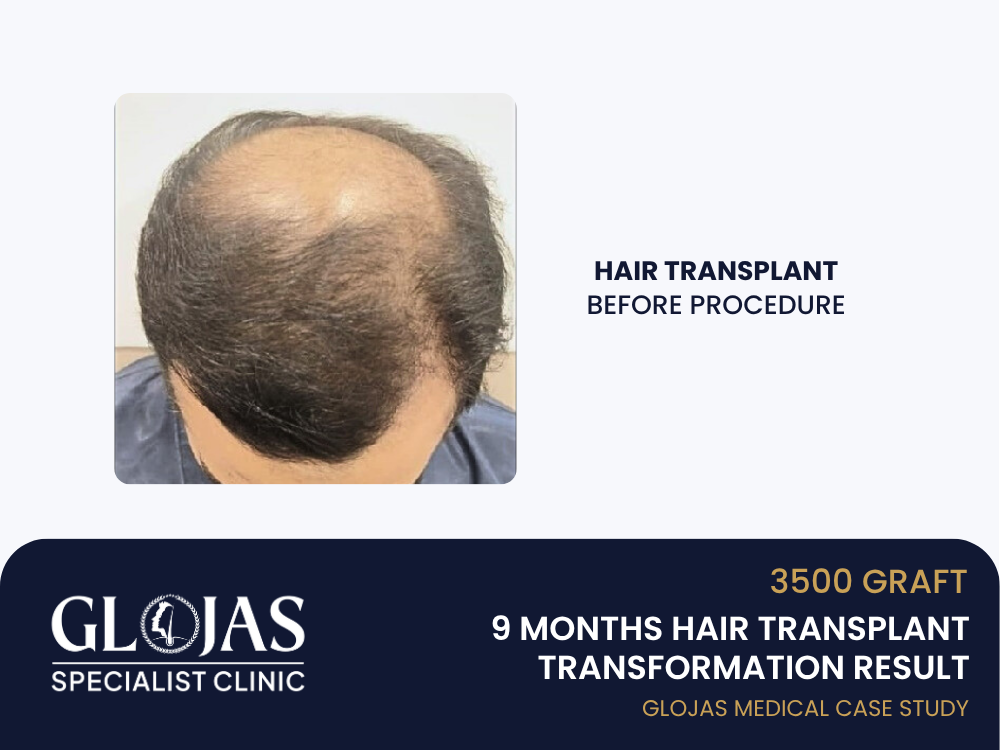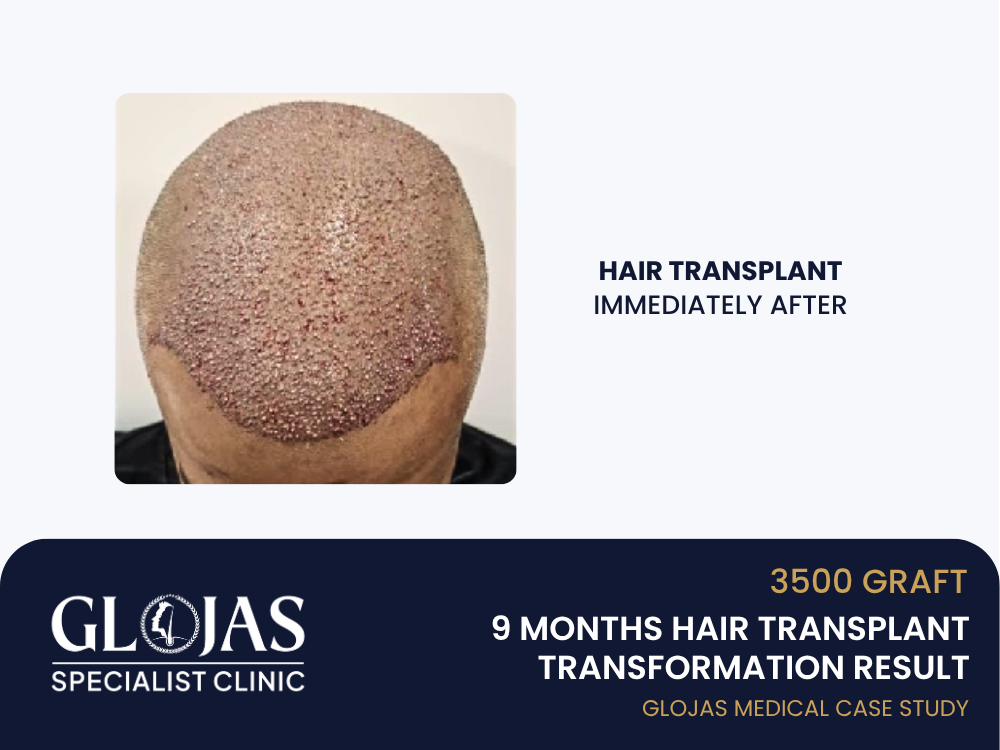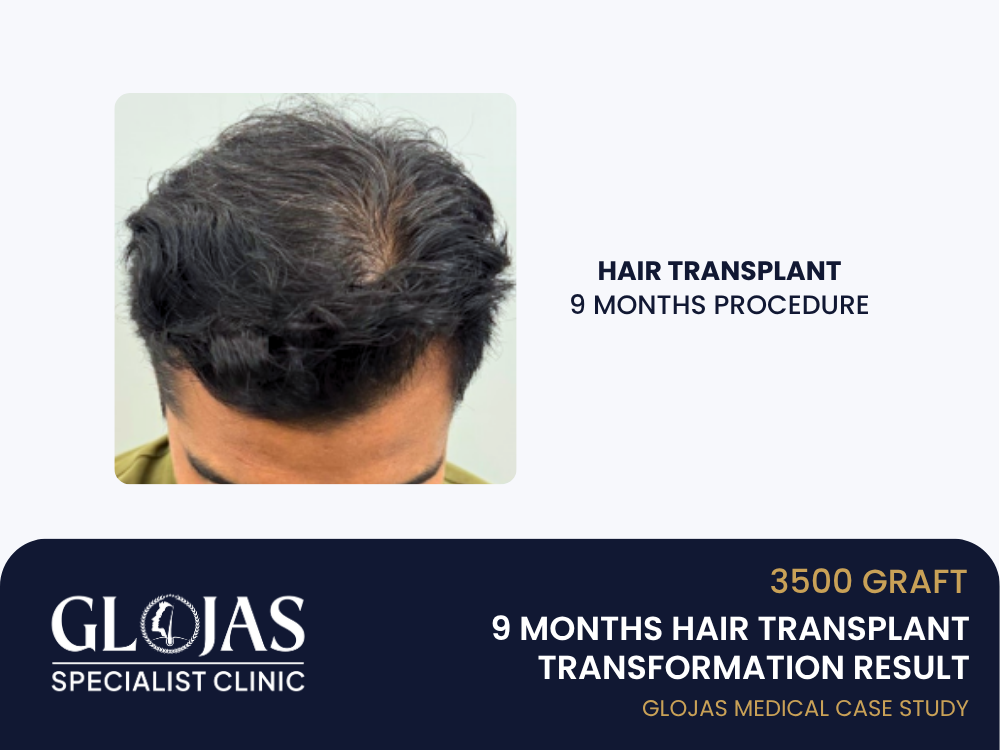If treatment is delayed, male pattern baldness can advance quickly. In this case, we explore how a 38-year-old male patient, experiencing Norwood level 4 hair loss, underwent a successful FUE Hair Transplant using 3,500 grafts, achieving a significant transformation in just 9 months.
Patient Profile
Name: Mr. H (identity confidential)
Age: 38
Hair Loss Level: Norwood 4
Concern: Deep frontal recession and crown balding
Hair Type: Coarse, straight, dark brown
Donor Area: Healthy and dense
Primary Goal: Restore frontal hairline and crown for a natural, fuller look
Mr. H had been struggling with increasing hair loss for nearly a decade. Initially managing it with shampoos and topical solutions, he eventually opted for a permanent solution as the recession worsened and baldness expanded to the vertex (crown).
What is FUE Hair Transplant?
FUE (Follicular Unit Extraction) is a modern, minimally invasive hair restoration technique. Hair follicles are individually removed from the donor area, which is the back of the scalp, and then implanted into areas that are thinning or balding.
Benefits:
No linear scar
Quick recovery
High graft survival rate
Natural-looking results
Suitable for different hair loss patterns
FUE is especially effective in treating multi-zone baldness, e.g, Norwood 4 cases, where both frontal and crown areas are affected.
Initial Consultation and Planning – Hair Transplant
During Mr. H’s consultation, the medical team evaluated his hair density, scalp laxity, donor capacity, and overall aesthetic goals. The most affected areas were:
Frontal hairline and temples: significant recession
Crown (vertex): wide balding area
Mid-scalp: slight thinning
Treatment Plan:
Total grafts needed: 3,500
2,000 grafts for frontal restoration
1,500 grafts for crown coverage
Design: Age-appropriate hairline with natural temple curvature
Technique: FUE using 0.8 mm punch
Procedure Overview

Date: Single-day session
Duration: Approx. 8.5 hours
Anesthesia: Local
Grafts extracted: 3,500
Implanted zones: Frontal zone + crown
Method: Manual extraction and implant pen technique
Process Breakdown:
Local anesthesia was administered to the donor and recipient areas
3,500 follicular units extracted from the occipital region
Grafts are sorted based on hair thickness and number per unit
Recipient incisions are made at a natural angle
Grafts implanted for high-density frontal and even crown coverage
Recovery & Timeline

Days 1–3: Mild swelling, redness in the recipient zone
Days 4–7: Formation and shedding of small scabs
Week 3–4: Shock loss phase – temporary hair shedding
Month 3: Initial signs of regrowth
Month 6: 60–70% hair density visible
Month 9: Significant, natural-looking coverage and improved density
9-Month Results

At his 9-month follow-up, Mr. H had regained a well-defined frontal hairline, with strong growth at the crown. The transformation dramatically altered his facial aesthetics, making him appear more youthful and confident.
| Zone | Before | After 9 Months |
|---|---|---|
| Frontal Hairline | Deep “M” recession | Strong, structured, natural hairline |
| Crown | Bald spot visible | 80–85% coverage with healthy regrowth |
| Donor Area | Dense and untouched | Slight thinning (not noticeable) |
| Confidence | Avoided short hairstyles | Wears open hairstyles proudly |
Patient Feedback
“This was the best decision I’ve made for my confidence. I didn’t just get my hair back — I got my confidence and youth back too.”
Mr. H was especially impressed with how undetectable the transplant looked and how well the implanted hairs blended with his existing ones.
Long-Term Maintenance
Shampoo: Mild formula used after 7 days
Styling: Normal haircuts after 3 weeks
Oral Finasteride: Advised to prevent future thinning
PRP sessions: Recommended every 6 months to support regrowth
Final result expected at 12 months, with continued thickening until month 15
5 Frequently Asked Questions (FAQ)
1. Is 3,500 grafts enough for Norwood 4 hair loss?
✅ Yes. For Norwood level 4, 3,500 grafts are typically sufficient to cover both frontal hairline and crown, especially if donor quality is strong.
2. When can I expect to see full results?
You’ll notice major improvement by month 9, but full results — including thickness and texture — typically appear by 12–15 months.
3. Does the transplanted hair fall out again?
No. Transplanted hair is DHT-resistant and permanent, as it’s taken from the safe donor zone at the back of the scalp.
4. Will the donor area look thin after extracting 3,500 grafts?
If done properly, no. Grafts are extracted evenly across a wide area, avoiding overharvesting and ensuring a natural appearance.
5. Is FUE painful?
Most patients report only minor discomfort. The procedure is done under local anesthesia, and recovery is relatively smooth with little downtime.
Conclusion
Mr. H’s journey proves that a well-planned FUE Hair Transplant using 3,500 grafts can restore not just hair, but also self-esteem and quality of life. His case is a great example of how modern hair restoration can effectively address moderate to advanced male pattern baldness, without scarring or significant downtime.
If you’re facing similar hair loss concerns, consulting a qualified hair transplant specialist early can make all the difference in your transformation journey.
